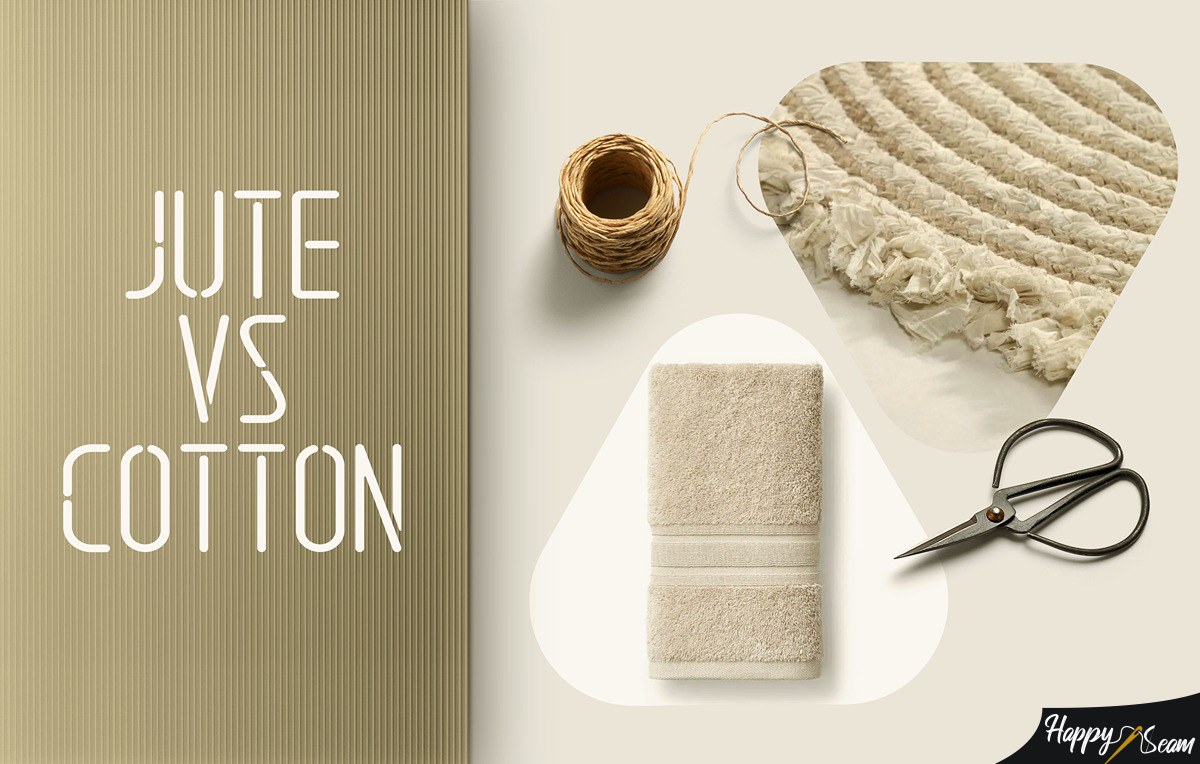Materials made out of natural properties are very popular on the market today. Jute and cotton fabrics are frequently used by manufacturers to produce breathable and high-quality pieces of clothing. Customers are delighted with the idea of wearing materials that promote sustainability while at the same time providing necessary comfort. There are various similarities and differences between jute and cotton.
Key Takeaways
- The jute fabric does not gain the most significant popularity in comparison to cotton fabric.
- The cultivation of cotton requires the use of fertilizers and constant attention, whereas cultivating jute is much more simple and time-saving.
- The jute threads are woven in a heavier and more durable way as opposed to cotton threads which are more delicately woven to provide a soft feel.
- Natural and eco-friendly materials such as jute and cotton are regarded as being high-maintenance in comparison to other materials which are synthetically made and not safe for the environment.
Jute vs. Cotton: How Do They Differ?
The most well-known natural fabric on the market is cotton. Jute fabric is the next best most well-known fabric made out of natural properties that are used by many people. Pieces made out of cotton are oftentimes more expensive than pieces made out of jute. Jute is more affordable in comparison to cotton because its cultivation is more simple and profit-making. Cotton is also known to be more comfortable to wear in contrast to jute.
The cotton fiber is very soft which provides a pleasant feel on the skin. The jute fiber can be very dense which makes it less comfortable than cotton. Both jute and cotton are very versatile and wearable fabrics while at the same time being characterized as sustainable and durable.
You can also read does 50% Cotton 50% Polyester Shrink?
Cultivation

Natural materials that are correctly grown and taken care of do not contain any chemicals or harmful components. Being environmentally safe, ecological, and degradable, cotton and jute make people feel comfortable in their clothing and help the environment without including toxic chemicals. The process of cultivation for cotton usually starts around the warmer months of the year because it can be damaged by ice and snow. The land is cleared to prepare it for soil and then seeds of cotton are planted using machines.
Some people also prefer planting the cotton seeds using their own hands. To make sure that the seeds are being protected, several products such as fertilizers have to be used and this process can become lengthy and meticulous. In comparison, the cultivation process of jute does not involve much effort or excessive use of fertilizers and it can be done during a rainy season.
It can also be raised on various types of soil by planting the seeds of jute and waiting for harvest after a couple of months. Raising jute is not as complicated and time-consuming as the process of raising cotton which makes it cost effective for farmers.
Weave
Cultivated jute stems are harvested and desolated. The fibers from the stem are removed by a process that involves soaking in water. Then, the fibers are separated and formed into long threads. The next step is straightening the fibers and spinning them into a yarn. To give some color to the fibers, they are often chemically dyed and the completed spool is shipped to manufacturing companies to be woven and eventually made into wearable clothing.
The yarns of the jute fabric are very strong and dense which make it suitable for the production of carpets, bags and drapes. To begin the production process of cotton, the leaves are separated from cultivated cotton plants. The cotton is then separated from the seeds and harvested through a machine. Then the cotton is created into bundles and taken to companies
producing textile. The fibers are then made into long and lightweight threads which are eventually spun to make a raw material from which pieces of clothing can be produced. Cotton can be woven or crocheted and made into items for everyday use such as tablecloths and comfortable pieces of clothing such as denim jeans.
The yarns of the jute are sturdy and solid in comparison to cotton yarns which are much more delicate and soft.
You can also read does 60% Cotton 40% Polyester Shrink?
Maintenance

It is very significant to properly take care of natural materials in order for them to be long-lasting and retain their original shape. Natural materials such as jute and cotton are often more delicate than synthetic materials and they require accurate and sensitive care. The jute fabric is frequently blended with fragments of other materials such as cotton in order to provide more durability for particular items. It is often recommended to dry clean items made out of jute because it is the safest way of maintaining their quality. If the particular items require washing, it is best to do it by hand by using gentle soap and cool water. Twisting the jute fabric is not ideal because of the possibility of shedding its fibers and damaging its condition. Taking care of jute fabrics should be done meticulously and with gentle care by always choosing the best option that fits its high-quality and natural properties.
Using cold water when washing items and clothing pieces made out of cotton is usually the way to go. High heat can easily damage the cotton fibers, thus causing the items to shrink and lose their original shape. Hot water can also cause color fading of cotton pieces so that is why it is very important to read the care label on the piece before attempting to wash it on your own.
Dry cleaning is also recommended when it comes to taking care of cotton pieces because it is far more soothing and less harsh than simply tossing the items in the washing machine. Natural materials should be maintained appropriately because of their sustainable and ecological characteristics.
You can also read the meaning of pre shrunk cotton.
Final Verdict
The popularity of both jute fabric and cotton fabric constantly increases because people nowadays are more educated and aware of the importance of sustainability and taking care of our environment. Jute and cotton require similar methods of proper maintenance and cotton is slightly more complex to cultivate.
The fibers of jute are more coarsely woven in comparison to cotton fibers which are woven in a more delicate way. Their differences make it suitable for producing products that are aimed to perform and be used differently while at the same time retaining their natural feel.
I have been in the embroidery field for over 10 years. My career first started when I was an apprentice to a local seamstress where I started to learn the basics of garment construction and alterations. That’s where I started to love sewing and began to hone my skills even more.



